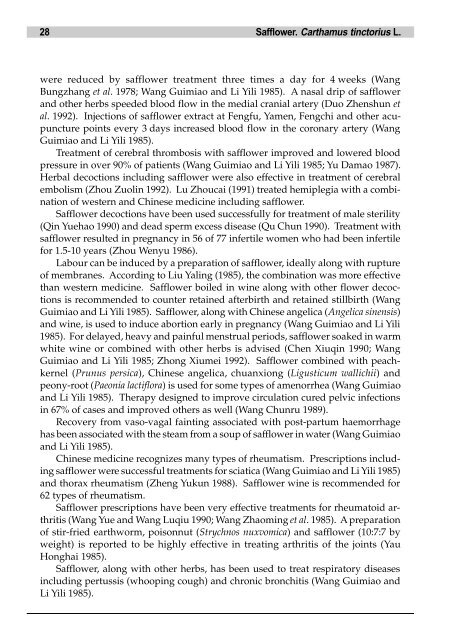Safflower, Carthamus tinctorius L. - Bioversity International
Safflower, Carthamus tinctorius L. - Bioversity International
Safflower, Carthamus tinctorius L. - Bioversity International
Create successful ePaper yourself
Turn your PDF publications into a flip-book with our unique Google optimized e-Paper software.
28 <strong>Safflower</strong>. <strong>Carthamus</strong> <strong>tinctorius</strong> L.<br />
were reduced by safflower treatment three times a day for 4 weeks (Wang<br />
Bungzhang et al. 1978; Wang Guimiao and Li Yili 1985). A nasal drip of safflower<br />
and other herbs speeded blood flow in the medial cranial artery (Duo Zhenshun et<br />
al. 1992). Injections of safflower extract at Fengfu, Yamen, Fengchi and other acupuncture<br />
points every 3 days increased blood flow in the coronary artery (Wang<br />
Guimiao and Li Yili 1985).<br />
Treatment of cerebral thrombosis with safflower improved and lowered blood<br />
pressure in over 90% of patients (Wang Guimiao and Li Yili 1985; Yu Damao 1987).<br />
Herbal decoctions including safflower were also effective in treatment of cerebral<br />
embolism (Zhou Zuolin 1992). Lu Zhoucai (1991) treated hemiplegia with a combination<br />
of western and Chinese medicine including safflower.<br />
<strong>Safflower</strong> decoctions have been used successfully for treatment of male sterility<br />
(Qin Yuehao 1990) and dead sperm excess disease (Qu Chun 1990). Treatment with<br />
safflower resulted in pregnancy in 56 of 77 infertile women who had been infertile<br />
for 1.5-10 years (Zhou Wenyu 1986).<br />
Labour can be induced by a preparation of safflower, ideally along with rupture<br />
of membranes. According to Liu Yaling (1985), the combination was more effective<br />
than western medicine. <strong>Safflower</strong> boiled in wine along with other flower decoctions<br />
is recommended to counter retained afterbirth and retained stillbirth (Wang<br />
Guimiao and Li Yili 1985). <strong>Safflower</strong>, along with Chinese angelica (Angelica sinensis)<br />
and wine, is used to induce abortion early in pregnancy (Wang Guimiao and Li Yili<br />
1985). For delayed, heavy and painful menstrual periods, safflower soaked in warm<br />
white wine or combined with other herbs is advised (Chen Xiuqin 1990; Wang<br />
Guimiao and Li Yili 1985; Zhong Xiumei 1992). <strong>Safflower</strong> combined with peachkernel<br />
(Prunus persica), Chinese angelica, chuanxiong (Ligusticum wallichii) and<br />
peony-root (Paeonia lactiflora) is used for some types of amenorrhea (Wang Guimiao<br />
and Li Yili 1985). Therapy designed to improve circulation cured pelvic infections<br />
in 67% of cases and improved others as well (Wang Chunru 1989).<br />
Recovery from vaso-vagal fainting associated with post-partum haemorrhage<br />
has been associated with the steam from a soup of safflower in water (Wang Guimiao<br />
and Li Yili 1985).<br />
Chinese medicine recognizes many types of rheumatism. Prescriptions including<br />
safflower were successful treatments for sciatica (Wang Guimiao and Li Yili 1985)<br />
and thorax rheumatism (Zheng Yukun 1988). <strong>Safflower</strong> wine is recommended for<br />
62 types of rheumatism.<br />
<strong>Safflower</strong> prescriptions have been very effective treatments for rheumatoid arthritis<br />
(Wang Yue and Wang Luqiu 1990; Wang Zhaoming et al. 1985). A preparation<br />
of stir-fried earthworm, poisonnut (Strychnos nuxvomica) and safflower (10:7:7 by<br />
weight) is reported to be highly effective in treating arthritis of the joints (Yau<br />
Honghai 1985).<br />
<strong>Safflower</strong>, along with other herbs, has been used to treat respiratory diseases<br />
including pertussis (whooping cough) and chronic bronchitis (Wang Guimiao and<br />
Li Yili 1985).

















